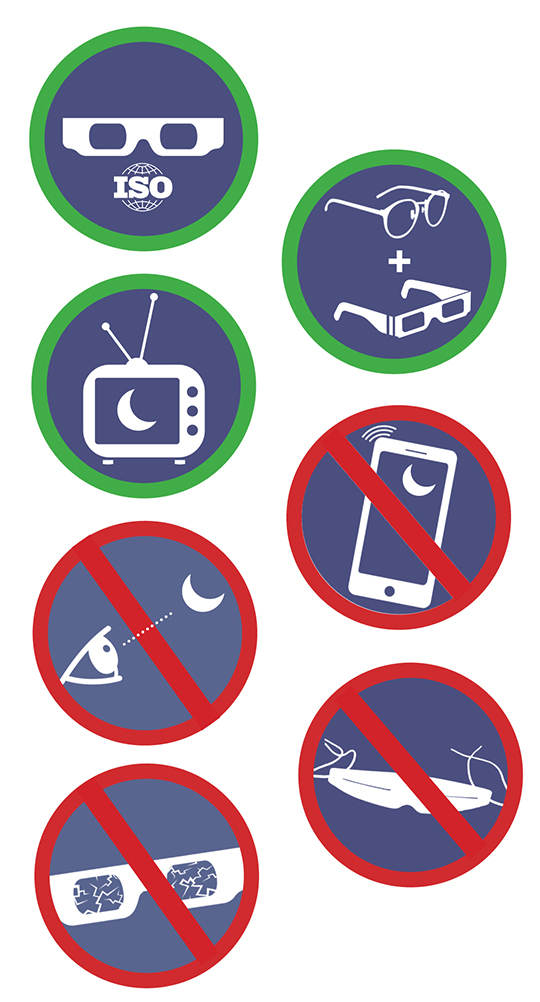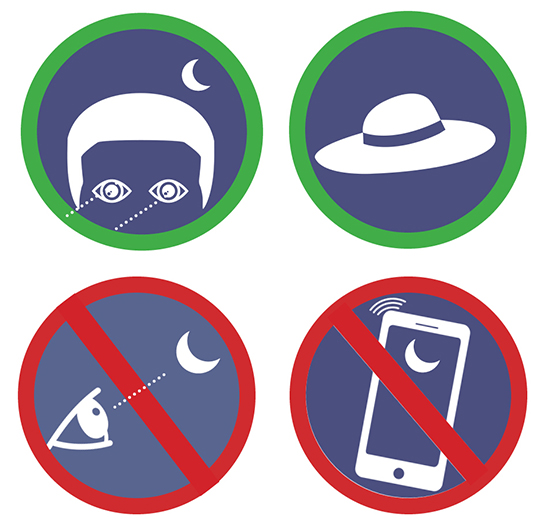*Original text in French. Translation authorized, but not revised by the Ministry of Health and Social Services.
In the event of any contradiction, the French content shall prevail.
- What is a solar eclipse
- How to protect your eyes during the upcoming solar eclipse
- Possible effects of the solar eclipse on eye health
- Being outdoors during the solar eclipse
What is a solar eclipse
A solar eclipse occurs when the Moon passes between the Earth and the Sun, casting its shadow on the Earth.
In places in the path of the Moon's shadow, the Sun will appear to have darkened. Depending on the distance between the Sun and Moon, and their position, it's possible to see two types of solar eclipse:
- Total eclipse: The Moon completely covers the Sun.
- Partial eclipse: The Sun and Moon are not perfectly aligned.
An eclipse path of totality encompasses the sectors where the eclipse is complete. During this phase of the eclipse, it seems as if night has fallen for a few minutes.
Outside the path of totality, the eclipse is partial, as the Moon only hides the Sun to a certain degree.
Nunavik's upcoming solar eclipses are partial
The next solar eclipses to hit Nunavik in the next ten years are partial eclipses. They are listed in the table below:
Solar Eclipse Dates | Type |
April 8, 2024 | Partial |
March 29, 2025 | Partial |
August 12, 2026 | Partial |
August 2, 2027 | Partial |
January 26, 2028 | Partial |
January 14, 2029 | Partial |
March 30, 2033 | Partial |
Caution!Don’t look at the solar eclipse with the naked eye for the duration of the event. Looking at the eclipse without suitable protection can cause serious permanent damage to your eyes. |
 How to protect your eyes during the upcoming solar eclipse
How to protect your eyes during the upcoming solar eclipse
It is important to supervise children and non-self-sufficient persons to ensure that they comply with the following instructions at all times.
Observing the Sun without using protective equipment should be avoided, as it can cause permanent damage to the eyes, even with conventional sun protection such as sunglasses or contact lenses. This risk increases during eclipses, as the Sun's luminosity decreases, reducing the eye's protective reflex.
If you'd like to observe the eclipse, there are safe methods available. Indirect methods are preferable, as the risks are lower than with direct observation.
Indirect observation of the eclipse
There are safe options for observing the solar eclipse indirectly, i.e. without looking directly at the sun:
- Use an eclipse projector to observe a small image of the sun at the bottom of a closed box. Learn how to build your own projector to watch solar eclipses safely .
- Observe the shadows as you cross the fingers of one hand over the other and look at the ground. The sunlight passing through the opening in the fingers will project the image of the eclipse onto the ground. To be safe rather than sorry, keep your back to the sun at all times.
- Watch the eclipse on the websites of several organizations that will be broadcasting the event live, including the Astrolab at Parc national du Mont-Mégantic .
Direct observation of the eclipse
People who choose to observe the eclipse directly must protect their eyes at all times by using solar eclipse glasses that comply with the international ISO 12312-2 standard.
Before using certified eyewear, you must:
- ensure that they come from a reliable supplier, either directly from the manufacturer or from a recognized distributor.
- check lenses and frames for damage before use.
- note that eclipse glasses can be worn over your regular prescription glasses if they thoroughly cover your eyes.
Only the Sun is visible through the eclipse glasses. All other objects and interior lights remain invisible. If such invisibility is not provided, do not use these glasses to observe the Sun.
Traditional Inuit snow goggles do not provide adequate protection for observing the eclipse.
Remember!
Sunglasses, even good quality ones with a very dark tint, do not provide enough protection to observe the eclipse, even for a few seconds.
Possible effects of the solar eclipse on eye health
During a solar eclipse, the many mechanisms that normally protect the eye, such as the automatic averting of the gaze, the eyelid closure reflex, and watering of the eyes, are reduced or absent, since the luminosity emitted by the Sun is less powerful.
However, because solar radiation is so intense during an eclipse, it can damage the eye's retina and cause permanent vision problems. Eye problems can emerge as:
- lesions in the retina that cause no pain on exposure, but may prove irreversible. These lesions create a reduction in vision caused by a permanently blurred or dark spot in the middle of the field of vision. They do not appear immediately, but several hours after viewing the Sun.
- lesions in the cornea caused by ultraviolet rays. These painful lacerations lead to a sharp drop in visual acuity and intolerance to light.
In the event of eye symptoms developing in the hours or days following viewing of the eclipse, it is advisable to consult an eye care professional without delay.
Being outdoors or on the land during the solar eclipse
Being outdoors during a solar eclipse is not a health hazard if you're not looking directly at the sun. You can enjoy your usual outdoor activities throughout the eclipse.
Caution!
Don't give in to the temptation to observe the solar eclipse, even briefly, without proper protection. It's best to wear a hat or cap.
 If you are on the land or simply outdoors
If you are on the land or simply outdoors
To protect your health and safety, as well as your physical and psychological well-being, please observe the following recommendations if you are on the land or outdoors.
- Do not look directly at the eclipse without proper protection for the duration of the eclipse.
- If you have to look up to the sky, we recommend keeping the sun out of your field of vision (e.g. standing with your back to the sun).
- Avoid observing or photographing the eclipse through a lens (e.g. cell phone, binoculars, telescope) without a suitable solar filter. Activities with this type of equipment should be postponed until after the eclipse to limit all risks.
